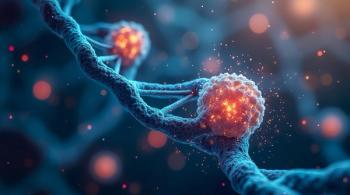
What Predicts Good Outcomes With Axi-cel? Investigators Support “Timely” Treatment
Investigators from Fred Hutchison Cancer Research Center hoped to gain insights into what factors can predict success with axi-cel in patients with relapsed or refractory diffuse large B-cell lymphoma (DLBCL).
As the use of chimeric antigen receptor (CAR) T-cell therapy moves into earlier lines of care in lymphoma, identifying when this is the best option for patients and when other novel treatments should be tried first is among the key questions for clinicians and investigators.
It’s a key concern in managed care. Studies presented a year ago during the American Society of Hematology Annual Meeting in Atlanta suggested that overall, using CAR T-cell therapy in second-line brought more durable responses than waiting until patients had received more lines of treatment. But on an individual patient basis, patients still relapse; the 24-month event-free survival rate for axicabtagene ciloleucel (axi-cel), sold as Yescarta, was 41%, comparedwith 16% for standard of care.
While clearly a huge leap forward, investigators still hope to gain insights into what factors can predict success with axi-cell in patients with relapsed or refractory diffuse large B-cell lymphoma (DLBCL). Real-world results recently published by investigators at Fred Hutchison Cancer Research Center aimed to shed light on this issue. Their results appeared December 1, 2022, in the Journal of Cellular and Molecular Medicine.
In sum, their findings show that prior responsiveness to chemotherapy is not a predictor of how a patient will respond to CAR T-cell therapy; in fact, the investigators write that this result is anticipated due to the unique mechanism of the customized therapy, which calls for a patient’s own T cells to be harvested and then genetically engineered into a personalized treatment. The engineered cells are then reinfused back into the patient to fight the cancer.
The authors’ real-world results support an important finding from the presentation of the
Our findings suggest that responsiveness to prior chemotherapy is not associated with post-CAR T outcomes. While these results are not surprising from a biological standpoint and can be explained by the mechanism of action of CAR T therapy when compared to traditional chemotherapy and transplant, there are clinical implications from these findings,” the Fred Hutchinson authors write. “Our data supports timely utilization of CAR T therapy in eligible patients even with immediate chemo-refractory disease without a need to use alternative therapies solely for disease stabilization purposes.”
Investigators examined 60 patients who underwent apheresis for axi-cel; 42 of these patients (70.0%) had primary refractory disease. Of the group, 16 patients (26.7%) had previously received a stem cell transplant. Bridging therapy, which is a common strategy in CAR T-cell administration, was given to 34 patients (56.7%) between apheresis and lymphodepletion. The overall response rate following axi-cel treatment was 63.3%.
Investigators reported that the median time from the last therapy to leukapheresis—when T-cells are collected—was 8.5 weeks. Median time from leukapheresis to lymphodepletion was 23 days, they reported. In their analysis, the authors wrote, they did not find any association between response to the last therapy before CAR T and overall survival—including the response to prearrival therapy or bridging therapy.
Patients with bulky disease do present a different case, however. Bulky disease was found to be an independent risk factor and investigators reported that “non-responsive patients that present with high-burden disease have a dismal outcome.”
In patients with bulky disease, investigators did find a link between failure to respond to pre-CAR T chemotherapy and post-CAR T-cell therapy outcomes.
Investigators also examined—and confirmed—the association between elevated pre-lymphodepletion lactate dehydrogenase (LDH) levels and post-CAR T outcomes, as this link has been reported as a negative factor for patients with DLBCL receiving axi-cel.
If a patient has bulky disease, “it may be reasonable to reduce the disease bulk
before CAR T therapy,” the investigators write. With choices that include monoclonal antibodies, antibody-drug conjugates (ADCs), and bispecific monoclonal antibodies, clinicians and patients have other paths to CAR T if immediate success seems less certain.
Reference
Iovino L, Wu QV, Voutsinas J, et al. Predictors of response to axicabtagene-ciloleucel CAR T cells in aggressive B cell lymphomas: A real-world study. J Cell Mol Med. 2022;00:1-8. doi: 10.1111/jcmm.17550
Newsletter
Stay ahead of policy, cost, and value—subscribe to AJMC for expert insights at the intersection of clinical care and health economics.














































